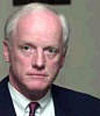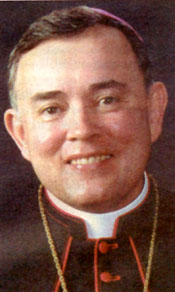 |
NEWS: May 18, 2004
Bird’s Eye View of the News
Atila Sinke Guimarães
POPE’S APPROVAL FOR THE FATIMA INTERFAITH SHRINE – John Paul II recently gave the religious authorities of Fatima a marble fragment of the tomb of St. Peter in Rome to be used in the new Holy Trinity Basilica that has been under construction since February 1994. The rector of the sanctuary is Msgr. Luciano Guerra. The new basilica will seat 9,000 people, making it the largest covered building in Portugal and one of the biggest Catholic churches in the world. It is scheduled to open in 2007, and is projected to cost close to $50 million, to be paid for by the offerings of pilgrims (The Tablet, March 27, 2004, p. 29).
There is no doubt about it, it's the very same inter-confessional shrine that was announced some months ago and had raised so much indignation among the Catholic faithful (see articles). Recently Msgr. Luciano Guerra himself confirmed that this new church will in fact be used for inter-religious purposes (“Controversy at Shrine Hasn’t Affected Construction,” Zenit, May 13, 2004).
Therefore, after the wave of indignation that has rolled over the Catholic world about the installation of a pan-religious shrine in Fatima, we have the final decision coming from Rome. With this symbolic gesture, John Paul II publicly takes a side in the controversy and in unspoken words gives his order: “Go ahead with the pan-religious shrine! It is what I want.” He is not only encouraging the Fatima authorities, but also obviously intends to close the door on the topic, sending the message to Catholics that the issue would no longer be open to discussion.
It is indisputably a good lesson for those naïve conservatives who often say that John Paul II is not aware of what the Vatican and other high Prelates are doing in his name. No one can deny that this time he is carrying out the progressivist agenda.
LA COSA NOSTRA I – The reader might remember that last June ex-Governor Frank Keating accused Bishops of acting like members of la Cosa Nostra – the code-name of the Italian Mafia. This was after 60 Bishops, including all the Californian Prelates, refused to collaborate with National Review Board (NRB), of which he was the chairman. The NRB had been created to investigate the sex abuse scandal in all the American Dioceses, present an objective picture of the situation, and propose the appropriate remedy. The mentioned Bishops balked at giving the necessary information about their Dioceses.

Disillusioned, Frank Keating resigned |
Several months before, in April 2003, Cardinal Roger Mahony had already tried to shut down the NRB by writing to the American Prelates calling for the NRB to conclude its study. After Keating’s strong statement opposing the maneuver, Mahony declared to the press, “I don’t know how he can continue to have the support of the Bishops” (Los Angeles Times, June 13, 2003). Pressured by the other NRB members, on June 16 Keating sent a letter to the head of the Conference of American Bishops, Bishop Wilton Gregory, presenting his resignation. It was hastily accepted, and a new NRB chairman was chosen, Anne Burke, an upstanding Illinois Court of Appeal Judge.
At the time of his resignation, I thought: Keating is an honest man and he obviously hit the mark with his metaphor. It's my opinion the NRB members were manipulated by the Bishops to pressure him to resign. The victor was Mahony. Now the Bishops will try to use the NRB as a tool to achieve their aims. Let’s wait and see if this lady will recognize what is going on and see through their plans for her and the other 12 NRB members.
LA COSA NOSTRA II – The NRB accomplished the first step of its mission on February 27, 2004. That day there were three important statements released simultaneously about the situation of the clergy in the United States. First, the John Jay report, i.e., the statistics of the company hired to investigate the status of the clerical sex scandal; second, the conclusions of the NRB. Among other things its members recommended an annual audit process be established in all the Dioceses, with a new investigation to begin in 2004; and third, the statement by Bishop Gregory, who decreed that clerical sex abuse scandal was over and had become “history.”
Some important lacunae were apparent in both the John Jay report and the NRB conclusions, as Dr. Marian Horvat pointed out in a timely article (click here).
However, the breaking news came May 11, when, in an interview with the Chicago Sun Times, Judge Anne Burke made available to the press private correspondence among Bishops regarding the proposals of the NRB. She also disclosed correspondence between her and various members of the American Hierarchy. Such documents can be viewed at National Catholic Reporter online.
The correspondence clearly indicates that many Bishops were considering shelving or delaying some of the NRB’s key recommendations, such as the second round of audits designed to measure diocesan compliance with child-protection policies. She reached the conclusion that the NRB had been manipulated by the Bishops. “In short, we were manipulated,” she stated in a March 30 letter to Bishop Gregory.

National Review Board member Robert Bennett and Chairman Anne Burke - manipulated by the Bishops - America, May 3, 2004 |
The picture that emerges from these letters together with the previous known data can be succinctly summarized.
• Unable to calm the public indignation or heal the consequences of the clergy sex abuse scandal, the Bishops created the NRB to give the impression that they would submit to the impartial judgment of this organ.
• With this, Catholic public opinion was led to believe that the Bishops were repentant for the acts of pedophilia and cover-ups and willing to subject themselves to impartial supervision. The NRB also believed this and thought that it would exert the role of an independent moral supervisor. However, a month after the statistics were released and the NRB conclusions made public (February 27), Burke learned that about three dozen Cardinals and Bishops had been exchanging correspondence that rebuffed the measures proposed by NRB to heal the pedophile crisis and denied its assumed role. Most of such correspondence was hidden from her, probably so that she would continue to think that the NRB would supervise the Bishops.
• Burke went to the February 27 press conference without knowing that the rug was being pulled from under her feet. She presented the NRB conclusions and gave the impression to the public that a healing process was underway supervised by the NRB.
• After that, the picture changed, that is, the correspondence came to light revealing that the Bishops did not intend to give NRB the authority everyone presumed it had.
• Realizing this, Burke wrote a letter to some Bishops (March 29) asking what were their real intentions, which produced among the Prelates new strong reactions against the role of the NRB.
• On March 30 she wrote to Bishop Gregory, the creator of the NRB, a final letter of complaint which concluded that the board had been manipulated.
• On May 11, she announced to the press that she will resign from the NRB in June.
Here are some samples of the correspondence:
• On February 2 Cardinal Edward Egan of New York wrote to Bishop Gregory: “We write to report that the undersigned Bishops …. are not in favor of extending these efforts until the matter has been discussed by all of the Bishops …. at their general meeting in November.”
• In mid-February, Cardinal Justin Rigali of Philadelphia, Archbishop John Myers of Newark, Archbishop Elden Curtis of Omaha, and the conservative Bishop Fabian Bruskewitz of Nebraska likewise affirmed that they were “opposed to any extension of the national audit regarding the sexual abuse of minors by clergy until all the Bishops …. have an opportunity to discuss this matter in executive session at our meeting in November 2004.”

Conservatives like Archbishop Chaput, above, and Bishop Bruskewitz join the front line against the NRB, and thus favor the cover-up - Our Sunday Visitor,May 2, 2004 |
• On February 12, more than a dozen Bishops from Connecticut, New Jersey and Pennsylvania declared themselves “troubled” to see that the NRB and the Office for Children Protection “appear to be expanding their competence, responsibilities, activities and studies in a dynamic autonomy.”
• On April 2, conservative Archbishop of Denver Charles Chaput was still more aggressive. In a response to Burke’s March 29 letter of inquiry about the Prelates’ intentions, he stated that she had assumed “the worst motives on the part of the Bishops …. Your language is designed to offend and contains implicit threats that are …. inappropriate for anyone of your professional stature.”
Chaput also questioned the need for the annual audits advised by the NRB. According to him, the Dallas Charter for the Protection of Children “nowhere requires an annual national audit.” He then attacked the competence of the lay organ: “It is not the NRB’s duty to interpret the Charter. The NRB is an important advisory body at the service of the Bishops. It does not and cannot have supervisory authority.”
In short, as soon as the Bishops had used the National Review Board as a front to clean up their image before Catholic public opinion, they put it aside like a squeezed orange of no more use to them.
This seems to be the dishonest procedure that Justice Anne Burke was referring to when she stated that the 13 members of the NRB had been manipulated. It’s my opinion that she is right. After another year, she and the other members of the lay panel came to realize that Frank Keating was right when he qualified part of the American Hierarchy as acting like la Cosa Nostra. Analogous ploys like the one used by Mahony last year to put out Keating are being brought into play now by a large group of Bishops, including some “holy” conservatives. It could be called la Cosa Nostra II.


Related Works of Interest
|
News | Home | Books | CDs | Search | Contact Us | Donate

© 2002- Tradition in Action, Inc. All Rights Reserved
|
 |
|